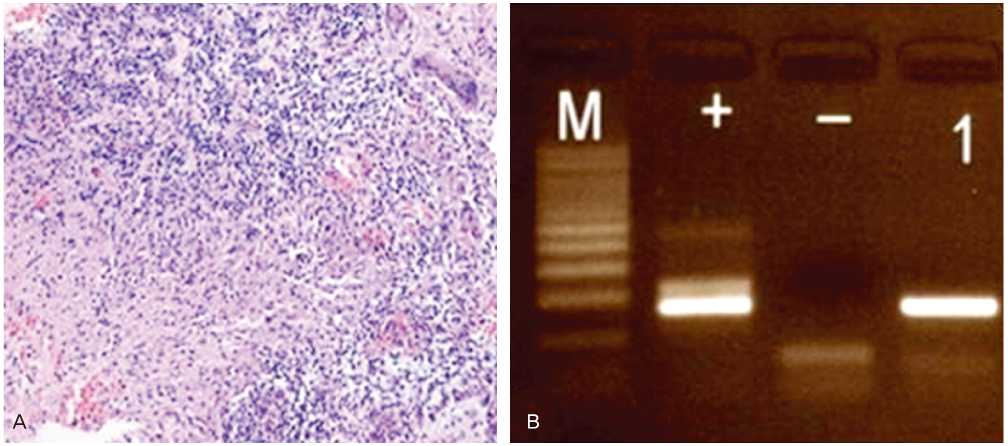Korean J Obstet Gynecol.
2012 Jun;55(6):429-432. 10.5468/KJOG.2012.55.6.429.
A case of postmenopausal pyometra caused by endometrial tuberculosis
- Affiliations
-
- 1Department of Obstetrics and Gynecology, Institute for Medical Sciences, Chonbuk National University Medical School, Jeonju, Korea. obgyn2001@hanmail.net
- 2Department of Obstetrics and Gynecology, CHA Bundang Medical Center, CHA University, Seongnam, Korea.
- KMID: 1783938
- DOI: http://doi.org/10.5468/KJOG.2012.55.6.429
Abstract
- Mycobacterium infection manifesting pyometra in postmenopausal women is a extremely rare disease that hardly responds to the usual treatment of pus drainage and antibiotics therapy. We present a case of a postmenopausal woman with pyometra caused by endometrial tuberculosis. Almost all of the pus could be drained through the stenotic cervical canal, with difficultly. The result of Pipelle endometrial biopsy was negative. However, her symptoms continued and fluid gradually re-accumulated in the uterine cavity, despite successful pus drainage and sufficient antibiotics use. Therefore, the endometrial tissue was obtained by fractional curettage after cervical dilatation to identify the accurate cause of pyometra. A pathologic examination and polymerase chain reaction confirmed the diagnosis of endometrial tuberculosis. After completion of antituberculous medication, she was doing well without further development of pyometra. In a case of postmenopausal pyometra, endometrial sampling should be performed to rule out endometrial tuberculosis.
Keyword
MeSH Terms
Figure
Reference
-
1. Chan LY, Lau TK, Wong SF, Yuen PM. Pyometra. What is its clinical significance? J Reprod Med. 2001. 46:952–956.2. Chan LY, Lam MH, Yuen PM. Sonographic appearance of Mycobacterium pyometra mimicking carcinoma of uterine corpus. Acta Obstet Gynecol Scand. 2005. 84:1124–1125.3. Sharma JB, Roy KK, Pushparaj M, Gupta N, Jain SK, Malhotra N, et al. Genital tuberculosis: an important cause of Asherman's syndrome in India. Arch Gynecol Obstet. 2008. 277:37–41.4. Güngördük K, Ulker V, Sahbaz A, Ark C, Tekirdag AI. Postmenopausal tuberculosis endometritis. Infect Dis Obstet Gynecol. 2007. 2007:27028.5. Simon HB, Weinstein AJ, Pasternak MS, Swartz MN, Kunz LJ. Genitourinary tuberculosis. Clinical features in a general hospital population. Am J Med. 1977. 63:410–420.6. Maestre MA, Manzano CD, López RM. Postmenopausal endometrial tuberculosis. Int J Gynaecol Obstet. 2004. 86:405–406.7. Gatongi DK, Kay V. Endometrial tuberculosis presenting with postmenopausal pyometra. J Obstet Gynaecol. 2005. 25:518–520.8. American Thoracic Society. CDC. Infectious Diseases Society of America. Treatment of tuberculosis. MMWR Recomm Rep. 2003. 52:1–77.
- Full Text Links
- Actions
-
Cited
- CITED
-
- Close
- Share
- Similar articles
-
- Pneumoperitoneum Caused by the Spontaneous Perforation of a Pyometra in an 80-Year-Old Woman: A Case Report
- Spontaneous Perforation of Pyometra Leading to Acute Abdomen
- Cervical xanthogranuloma in a case of postmenopausal pyometra
- Large pyometra mimicking the distended bladder in a postmenopausal female patient
- Spontaneous uterine perforation due to pyometra presenting as acute abdomen in older age



